StretchSense
Stretch sensors are a type of sensor designed to measure soft structures, including soft robots and the human body. StretchSense, a company from New Zealand, has developed commercially available stretch sensors that can measure either stretch, bend, shear, or pressure. These stretch sensors are essentially flexible capacitors. When the sensor deforms (due to stretching or squeezing) its capacitance value changes. The sensor sends data about its capacitance to a Bluetooth enabled device, and the StretchSense App translates the data to give a user highly precise information about what the sensor is detecting. StretchSense sensors can be made in various sizes, elasticities, and sensitivities depending on desired application.
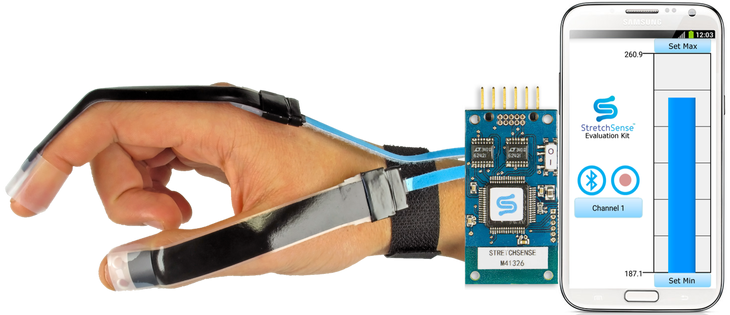
The inside of the stretch sensor consists of a stretchable signal electrode sandwiched between two ground electrodes which are separated by silicone dielectric insulators. Since the sensor is essentially a flexible parallel plate capacitor, the two dimensions that change when the sensor is stretched are thickness and area of the conductive layers. Stretching the sensor increases area and decreases thickness which both contribute to an increase in capacitance. Since capacitors resist a change in voltage, the capacitance can be indirectly measured through an applied voltage. By applying a voltage to the sensor and comparing the actual voltage output to what would be expected without a capacitor, the capacitance of the sensor can be determined.

StretchSense offers two versions of stretch sensor: A silicone based sensor and a fabric based sensor. The silicone variety offers a set of mounting holes to attach to your system, while the fabric variety has a thin sew-able region on each side of the sensor which is perfect for integrating with wearable applications.
Silicone stretch sensor
![]()
Fabric stretch sensor
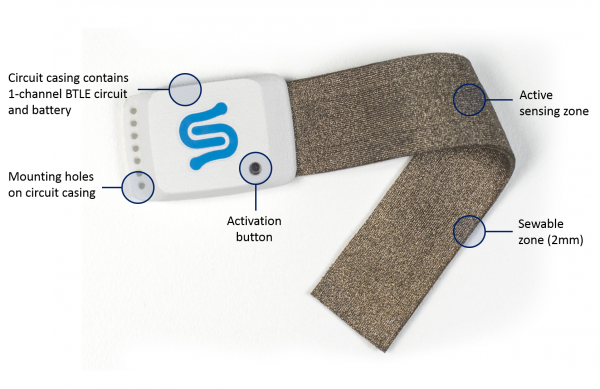
| Some of the information contained in this web site includes intellectual property covered by both issued and pending patent applications. It is intended solely for research, educational and scholarly purposes by not-for-profit research organizations. If you have interest in specific technologies for commercial applications, please contact us here. |
Specifications
Silicone Stretch Sensor
![]()
![]()
![]()
Fabric Stretch Sensor

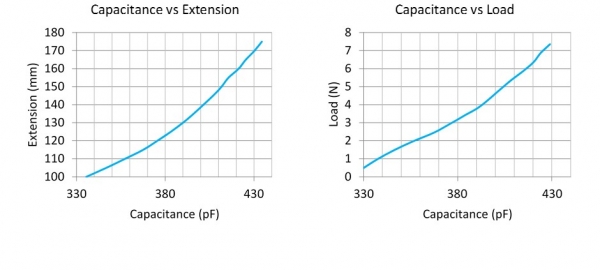

User Instructions
Pairing one or more sensors to circuit
One sensor
![]()
Multiple sensors
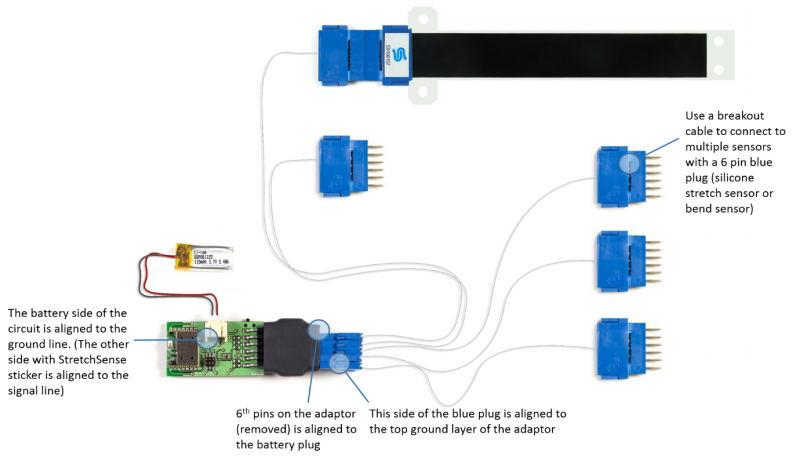
Using the App
The Apps are available to download for free on the Google Play Store.
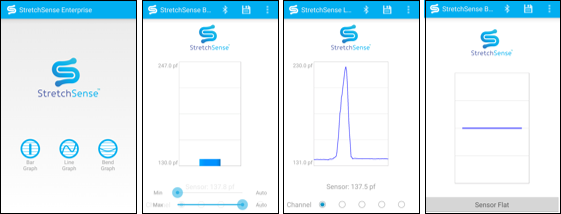
Instructions for Enterprise Kit App
- Select the Sensor mode from the main menu. Press the Bluetooth symbol in the App. Select the entry named “StretchSense#####” where the ##### are the five digits of the serial number on the sensing circuit.
- Once the sensor is connected, the graph in the App will respond to stretching and deformation of the sensor.
- To start recording data from the sensor, press the save symbol in the App. The App will begin to record capacitance versus time as measured by the sensor. To stop recording, press the save symbol again.
- To retrieve recorded data, connect your Android device to a computer by USB. Ensure that your Android device is enabled as a USB media device. On your computer, browse to the directory of your Android device. Recorded data will be saved in a folder titled “StretchSense Data”.
- The data is stored in a comma separated value (.csv) file, in pairs of Capacitance (in picoFarads), and Timestamp (in milliseconds).
Instructions for Fabric Evaluation Kit App
- Press the activation button on the case. After pressing the button, you should observe a light flashing within the sensor. This indicates that the sensor is ready to be paired to the App.
- Press the Bluetooth symbol on the action bar at the top of the App. Select the entry named “StretchSense” in the available devices list. If no devices appear, press the button on the sensor again and press “Scan” in the App.
- Once the sensor is connected, the bar graph in the App will respond to stretching and deformation of the sensor.
- Tap on the graph in the App to change its scale. Minimum and maximum can be specified in picoFarads. The graph can be set to scale automatically by setting the Min to the far left, and the Max to the far right.
- To retrieve recorded data, connect your Android device to a computer by USB. Ensure that your Android device is enabled as a USB media device. On your computer, browse to the directory of your Android device. Recorded data will be saved in a folder titled “StretchSense Data”.
- The data is stored in a comma separated value (.csv) file, in pairs of Capacitance (in picoFarads), and Timestamp (in milliseconds).
Demo Videos
Silicone Stretch Sensor Demo
The video below shows the stretch sensors sending data to a phone via bluetooth. It also shows an example of how multiple sensors can be easily incorporated into one system by showing a glove with stretch sensors over each finger.
Other StretchSense Sensor Demos
Case Study: Active Elbow Brace
Credit: A. Veale, Auckland Biomimetics Insitute
A group at the Auckland Biomimetics Institute is using StretchSense sensors to control an active soft elbow brace. The above video shows their elbow brace which is the first to feature slimline and flexible fluidic muscles (arranged antagonistically on either side of the brace in similar fashion to biological muscles).
Stretch sensors are sewn along the length of the muscles and are pre-tensioned so they move in concert with the muscles as they contract.
As the brace is actuated, the strain sensors provide feedback on the current orientation of the joint. This control can be seen at the beginning of the video when the lego model of the elbow joint moves in unison with the actuation of the elbow brace.